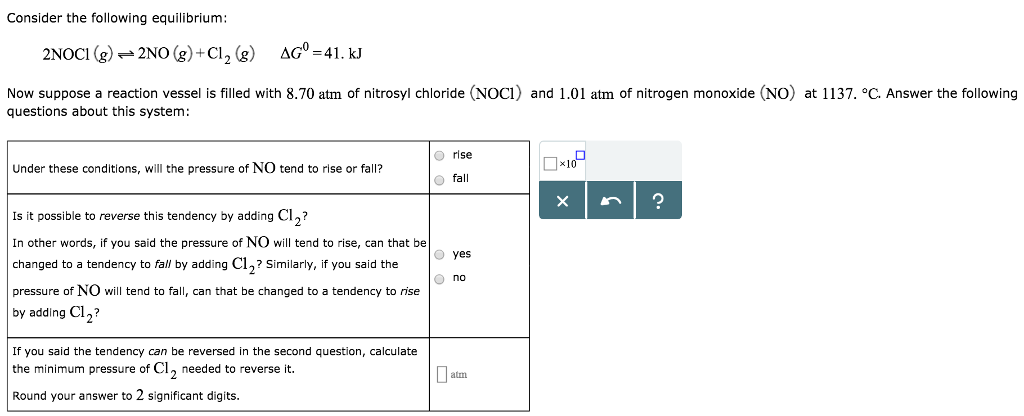Consider the following equilibrium: AG⁰=41. KJ 2NOC1 (g) → 2NO(g) + Cl₂ (g) low suppose a reaction vessel is filled with 8.70 atm of nitrosyl chloride (NOC1) and 1.01 atm of nitrogen monoxide (NO) at 1137. °C. Answer the following uestions about this system: Under these conditions, will the pressure of NO tend to rise or fall? Is it possible to reverse this tendency by adding Cl₂? In other words, if you said the pressure of NO will tend to rise, can that be changed to a tendency to fall by adding C1₂? Similarly, if you said the pressure of NO will tend to fall, can that be changed to a tendency to rise by adding Cl₂? If you said the tendency can be reversed in the second question, calculate the minimum pressure of Cl₂ needed to reverse it. Round your answer to 2 significant digits. Orise O fall O yes Ono atm 0×109 ?
Consider the following equilibrium: AG⁰=41. KJ 2NOC1 (g) → 2NO(g) + Cl₂ (g) low suppose a reaction vessel is filled with 8.70 atm of nitrosyl chloride (NOC1) and 1.01 atm of nitrogen monoxide (NO) at 1137. °C. Answer the following uestions about this system: Under these conditions, will the pressure of NO tend to rise or fall? Is it possible to reverse this tendency by adding Cl₂? In other words, if you said the pressure of NO will tend to rise, can that be changed to a tendency to fall by adding C1₂? Similarly, if you said the pressure of NO will tend to fall, can that be changed to a tendency to rise by adding Cl₂? If you said the tendency can be reversed in the second question, calculate the minimum pressure of Cl₂ needed to reverse it. Round your answer to 2 significant digits. Orise O fall O yes Ono atm 0×109 ?
Chemistry: Principles and Reactions
8th Edition
ISBN:9781305079373
Author:William L. Masterton, Cecile N. Hurley
Publisher:William L. Masterton, Cecile N. Hurley
Chapter12: Gaseous Chemical Equilibrium
Section: Chapter Questions
Problem 56QAP: Sulfur oxychloride, SO2Cl2, decomposes to sulfur dioxide and chlorine gases. SO2Cl2(g)SO2(g)+Cl2(g)...
Related questions
Question

Transcribed Image Text:Consider the following equilibrium:
2NOC1 (g) → 2NO(g) + Cl₂ (g)
AG = 41. KJ
Now suppose a reaction vessel is filled with 8.70 atm of nitrosyl chloride (NOC1) and 1.01 atm of nitrogen monoxide (NO) at 1137. °C. Answer the following
questions about this system:
Under these conditions, will the pressure of NO tend to rise or fall?
Is it possible to reverse this tendency by adding Cl₂?
In other words, if you said the pressure of NO will tend to rise, can that be
changed to a tendency to fall by adding C12? Similarly, if you said the
pressure of NO will tend to fall, can that be changed to a tendency to rise
by adding Cl₂?
If you said the tendency can be reversed in the second question, calculate
the minimum pressure of Cl₂ needed to reverse it.
Round your answer to 2 significant digits.
Orise
O fall
O yes
O no
atm
0×10
X
?
Expert Solution
This question has been solved!
Explore an expertly crafted, step-by-step solution for a thorough understanding of key concepts.
Step by step
Solved in 4 steps with 1 images

Knowledge Booster
Learn more about
Need a deep-dive on the concept behind this application? Look no further. Learn more about this topic, chemistry and related others by exploring similar questions and additional content below.Recommended textbooks for you

Chemistry: Principles and Reactions
Chemistry
ISBN:
9781305079373
Author:
William L. Masterton, Cecile N. Hurley
Publisher:
Cengage Learning

Chemistry for Engineering Students
Chemistry
ISBN:
9781337398909
Author:
Lawrence S. Brown, Tom Holme
Publisher:
Cengage Learning

Introductory Chemistry: A Foundation
Chemistry
ISBN:
9781285199030
Author:
Steven S. Zumdahl, Donald J. DeCoste
Publisher:
Cengage Learning

Chemistry: Principles and Reactions
Chemistry
ISBN:
9781305079373
Author:
William L. Masterton, Cecile N. Hurley
Publisher:
Cengage Learning

Chemistry for Engineering Students
Chemistry
ISBN:
9781337398909
Author:
Lawrence S. Brown, Tom Holme
Publisher:
Cengage Learning

Introductory Chemistry: A Foundation
Chemistry
ISBN:
9781285199030
Author:
Steven S. Zumdahl, Donald J. DeCoste
Publisher:
Cengage Learning

Introductory Chemistry: A Foundation
Chemistry
ISBN:
9781337399425
Author:
Steven S. Zumdahl, Donald J. DeCoste
Publisher:
Cengage Learning

Principles of Modern Chemistry
Chemistry
ISBN:
9781305079113
Author:
David W. Oxtoby, H. Pat Gillis, Laurie J. Butler
Publisher:
Cengage Learning

Chemistry: The Molecular Science
Chemistry
ISBN:
9781285199047
Author:
John W. Moore, Conrad L. Stanitski
Publisher:
Cengage Learning